The average home is heated by devices that require grid power to operate. When winter weather knocks out our power, our homes can become dangerously cold.
It is not only a matter of comfort; if the temperature drops too low, our pipes will be in danger of bursting as they freeze.
There are many DIY options for heating sources, and often, they are simple to build, but they often are not as effective as the off-grid heating options, which are widely available in-store and online.
Safety First
When we are trying to heat our homes without the aid of the electrical grid, we often must rely on devices that burn fuel that radiates heat. Unfortunately, the major issue is that burning these fuels will generate carbon monoxide, an odorless, colorless, tasteless, and lethal gas.
Related: The Best Places Where You Can Store Fuels Safely In An Emergency
Therefore, it is critical that any backup heater you buy is certified and that you adhere to all the manufactures instructions regarding safe use and ventilation.
Carbon monoxide is a massive threat, but it is not the only problem these backup heaters can pose. Anytime you introduce an alternate heat source into your home, you run a significant risk of fire. Therefore, you must stay vigilant and keep all flammable materials away from your heaters.
When buying backup heaters for winter power outages, choose models with tip-over protection and an oxygen depletion sensor. These two features could save your life and your home.
Problems With Backup Heaters
There is one massive problem with using smaller backup heaters, which does not have to do with safety. These heaters are designed to heat small areas and, therefore, will not heat your entire home.
Consequently, you will have to consider which areas of your home require heating and purchase heaters specifically for those rooms and spaces.
Wood Stove
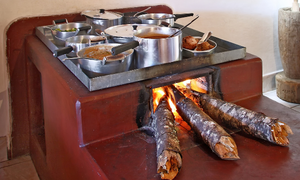 Millions of homes around the planet rely on a wood stove for heat and cooking, and it serves these families well.
Millions of homes around the planet rely on a wood stove for heat and cooking, and it serves these families well.
However, while this is an option for heating areas of your home, it comes with some problems that you will need to solve well before using it.
The most significant issue is that the stove will need its chimney vented to the outside of your home safely and effectively. This is not something you want to whip up on the fly after the lights go out; the stove pipe chimney must be in place and adequately installed first.
The second issue is that a wood stove requires a lot of wood which you will need to have on hand before winter takes away your electricity. For most of us, keeping a healthy supply of firewood is simply not practical unless we regularly use a wood-burning stove, fire pit, or fireplace.
Another issue is that wood stoves are not portable, so it would only be effective to heat the room that the stove is installed.
Wood stoves have the advantage of being able to be used for cooking food and heating water. With a bit of ingenuity, you can mount water tanks to the side of a wood stove or wrap the stove pipe in copper tubing, for hot water on demand. Here’s how you can make a simple water heater that provides you with free hot water each time you use your stove.
Wood Burning Fireplaces
A fireplace is a decent way to provide heat to a room; after all, it was the go-to method for much of history.
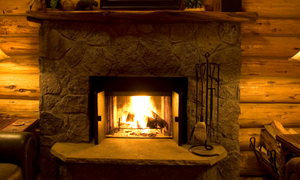
However, wood-burning fireplaces have similar disadvantages and safety issues as wood stoves.
One of the most significant issues with a wood-burning fireplace is that unless your home already has one in place, it is not practical to have one installed.
Related: How to Get a Year Supply of Firewood for $10!
Like wood stoves, fireplaces also require regular cleaning and maintenance to keep them operating safely and effectively.
Propane Heaters
Propane is a safe and stable fuel source that is always widely available. Many backyard grills use propane as a fuel source, and if you have a propane grill, it makes sense also to use a propane heater as a backup heat source.
There are many models of propane heaters on the market in various sizes and BTU ratings which means that you will be able to find an option to suit any space in your home that you need to be heated.
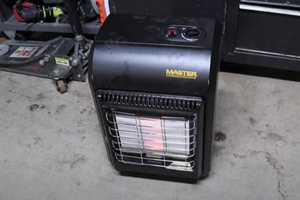 An advantage of some propane heaters is that they use the 1-pound cylinders that you would often see used to run camp stoves and lanterns.
An advantage of some propane heaters is that they use the 1-pound cylinders that you would often see used to run camp stoves and lanterns.
If you do a lot of camping, or use a propane camp stove as a part of your preps, you can stock a surplus of these 1-pound cylinders to use for your heater.
You must remember that any heater you choose must be rated for indoor use and follow all the manufacturer’s directions to ensure safe and effective operation.
Related: What’s the Best Fuel to Stockpile for Survival?
When using a propane heater with a 20-pound or larger cylinder, keep the gas cylinder outside the home in case any gas escapes. Propane is heavier than air and will settle in the lowest areas of your home, resulting in a significant risk of explosion.
For portable and off-grid heating, propane heaters are a good option worth considering.
Kerosene Heaters
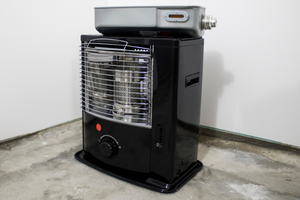 Kerosene heaters are less desirable but still viable options for off-grid backup heating.
Kerosene heaters are less desirable but still viable options for off-grid backup heating.
These heaters usually use a wick that draws the kerosene from a fuel tank. The wick is lit, and the heat generated is harnessed and directed to provide heating.
In some cases, these heaters will use a battery-operated fan to push the heated air into the room. Many kerosene heaters are rated for indoor use, but they still carry risks you must be aware of before relying on them for emergency heat.
Kerosene heaters have similar carbon monoxide risks but have the added risk of potentially toxic fumes from the kerosene evaporating. In addition, as kerosene burns, it can also release sulfur and nitrogen dioxide, which can become dangerous without proper ventilation.
Clean kerosene can also be hard to find and will need to be rotated regularly to avoid having the kerosene go bad.
When the power fails during the chilly winter months, it is critical for us to have alternate methods of heating our homes, as well as keeping our plumbing from freezing.
In these cases, small portable heaters are precisely what we need to get through those cold and dark winter nights.
You may also like:
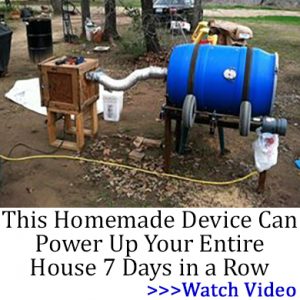 Delicious Recipes Using Cattails – “The Supermarket of the Swamp”
Delicious Recipes Using Cattails – “The Supermarket of the Swamp”
70+ Projects That Help You Survive Long-Term Without A Grid (Video)
The Black Walnut Hull Remedy That Cleans Your Intestines Of Parasites
The Mindset of Freedom: What Every Prepper Can Learn from Atlas Shrugged

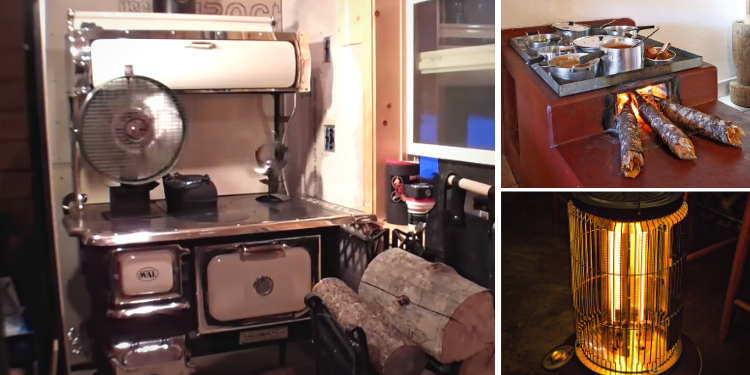














Just be very safe, no matter what kinda heat you use.
I was burnt very badly in 88, hooking up a propane stove.
It will make you scream and “pain like you never felt before”, then they scrub all the burnt skin off your body every day for 20 days. For me.
Then they send you home to take care of your self.
Just part of life, I guess…
Stay sharp
Deep
Not really…
Just very, “captain obvious”. Like; the sky is “blue” on a clear day, obvious!
I like this Mr Buddy I bought for the freezing cold when I tent camped but I sat up and wouldn’t let myself fall asleep with that thing running. It’s pretty safe but the thought of getting burned horrifies me. It should help you warm up while you’re getting your core body temperature up; then you shut it off and pile on the layers of blankets.
We have a Mr. Buddy also. They work great – we do like you; we wait until it warms up our truck bed with topper, turn it off, and sleep great
I have 4 Mr heater Buddys. They have kept me warm in the winter for over 5 years now. Even kept me and my adult daughter and her Pit warm through a week long power outage due to a snowstorm that had her stranded with me. At that time, I only had one, and, putting blankets over the doorways, we slept good in the living room. Only could get 4 hours of sleep at night before I had to wake up and replace the tank. We piled on three or four blankets, kept the living room blanketed off.
I should add two things: 1: at the time, my house, built in 1945, had a very poor foundation, there were cracks and holes everywhere. Original 1945 windows, that leaked air, no insulation, plastic siding, and an over 20 year old roof. The oil furnace had quit working about a year before…Had covered the 2’x 3′ hole to the crawlspace with a rubber baked rug. Still, it was only 35* inside.
and, 2: I contacted the Mr Heater Buddy manufacturer to ask why you couldn’t use the 20# tanks inside. They responded that the 20# tanks and all tanks larger will off gas when they get too hot. Only the 1# tanks won’t let off gas if they get hot. You do NOT want your tank to spill out excess gas inside!!!
They are perfectly safe to use and, since I still don’t have a furnace or any other way to heat, use them all winter with no problems. I will, though, only use them during the day, using plug in space heaters at night so I can sleep through the night!!!
They are expensive, but I got all 4 of mine on sale.
Again, just be sure to follow safety rules: don’t put near any furniture or curtains, and don’t use them if you are leaving the house. I turn mine off if I have to go to town, even if it means my house will be pretty cold when I get back, and my kitty will be cold!
Brian Myers
It was because of someone else, that was the reason I got burned in the first place.
Sometime, “obvious is hiding somewhere you don’t see it, till it’s too late”. HUMMMMM.
Hard lesson to learn. Trust no one.
Wood stove like all heat. Follow the rules of thermodynamics. A good sized one can heat your entire house.
Look this a lifestyle not a If when it happens.
So yeah get it installed and get wood.
The rest can’t be used indoors unless you wanna die
I think a rocket stove is the best way to go as it does not need a lot of wood and last a long time. You can build one out side and in side. They are small and very efficient.
I have to agree. They use less wood, give off less smoke and if combined with thermal mass are a great way to heat a structure. The clowns in the EPA are trying to ban wood stoves, so the “less” smoke, the better. We’re building a new 1,300 sq/ft house and the rocket stove will be in our walkout basement where I can creat the thermal mass to radiate heat outward and up through the floors.
EPA Clowns have already decimated certain parts of the wood stove industry. Just ask the people at Alpha American/Yukon Jack, oh i forgot, ya can’t because they went out of business! In a nutshell they cranked down on the particulate emissions and that by itself eliminated one entire class of home heating appliances. Wiped out all the multi-fuel stoves. Numerous dual and triple fuel stoves are illegal now and the ones that are still legal must either have catalysts or some other way to reduce particulate emissions down to almost nothing. I was planning to buy a multi-fuel stove for my home because of it’s obvious advantages. Most namely the advantage is that if your heater runs out of wood heat the heater kicks in on electric or propane and the home stays warm until you get home. Think about this, if you run wood heat and live alone there is definitely a time you HAVE to be home by in the wintertime. Or stuff will start to freeze and break. There’s no goin to the girlfriend’s for the weekend, or say maybe out of town for a couple days UNLESS you have another thermostatically controlled heating system in your house. That was the beauty of the multi-fuel units, they allowed you to come home to a warm house even if you were away for a bit and all in one fairly compact unit. Obama and company killed that. I mean maybe i’m being a troglodite here, but wood stoves are supposed to smoke! Yes, there are instances where certain weather patterns and stove/heater types in more densely populated areas can create a lot of smoke for other homeowners to deal with. Generally a transient issue that goes away when full heat is built in the unit. Some places have just banned wood stoves for heating altogether! Mostly in liberal areas and some in densely packed communities. And we can’t forget our friends at the home insurance company. They don’t like wood heat at all because of the obvious fire hazard that they may hafta pay for. So forget having a wood stove as your primary heat in some areas if you want to have home insurance, or maybe i should say AFFORDABLE home insurance as some will allow you to have after you’ve jumped through all their installation hoops and pay them a higher risk premium every month. I live in the middle of acres of heavily wooded land. Recently had to do some clearing for a house to be built. And i cleared the least amount of trees possible to be able to get power lines in, driveway, water lines, etc. And i have years worth of wood cut right now and still have even more to finish cutting up. I definitely will find some way to use this vast renewable resource of free heat.
You going vent it outside ? You going feed it every 20 minutes
Folks the e.p.a. Probably won’t be around if everyone is freezing to death? But I’m not sure about that? I’m thinking that if I need to stay warm and cook in a shtf type deal then I’m gonna put back whatever works for me and mine. They can’t put us all in jail, right?
Pat, can you expand on your idea of inside/outside. Are you suggesting the firebox would be outside but the flame path would go inside thru a thermal mass in the living area? I am interested, please respond.
They did not mention corn burner stoves. These use kernal corn, and are more efficient than wood burning stoves, and your house will smell like popcorn! They, like wood, need an outside vent, but work very well. They will also work with wood pellets, often cheaper than buying firewood, and are more efficient.
Requires corn
You do know that corn and pellet stoves need electricity to run their blowers and augers?
Also need electric to operate. A little counterproductive in a power outage unless you run a generator.
Also, with fireplaces, they aren’t very efficient unless you have a blower system to move the heat around the firebox to the house. Otherwise, an open fireplace will draft air inside the house up the chimney and this draft will exert a vacuum. This will suck cold air from the outside from the most least airtight source, normally windows and doors, thus actually in some cases causing a colder house than a warmer one.
We had one while I was married to my ex. He wanted a fireplace so bad and everyone told him to install a blower, but, you know, he knew it all and didn’t think we needed one. Well, whenever he lit that fireplace the whole house got cold. It got to the point we never lit the fireplace anymore. It became a decoration and a place to hang our stockings at Christmas.
Hey Keester. These days an open fireplace is NOT the way to go. I remember some old movies where they showed a fireplace big enough to walk in to. Looked really cool but horribly inefficient. These days you can build a fireplace with an airtight wood stove jammed into the front of it. The airtight has a pipe going to the outside that feeds fresh outside air to the wood stove. And the stone mass around the fireplace itself can be built in such a way that you have channels built into the stone so that cold air is drawn in at the bottom and as the mass heats up the cold air exits at the top of the mass as warm air. So you get heating both from the airtight and the mass of stone which should stay warm for quite some time giving you heat even after the fire goes out. Or if you have enough money build a dedicated masonry “kachel offen” like many still have in Europe. This masonry heater is designed to stay warm long after the fire has gone out. So you give it a good firing before you go to sleep and this stays warm all night long. They can be built so that you can even cook food with it and even heat water. A bit pricey but if built properly will last for many years.
Your last para. describes a “Russian ” fireplace or furnace. Often used 30 or 40 tons of laid up rockwork in the center of a house which when heated ,radiated heat outward to suronding house. Burned straw in a raging fire to heat rockwork, let fire go out and house stays warm for days.
That is why a correctly installed fireplace should have a “vent” system so it can draw cold air through the “vent and directly into the firebox. Without the inlet vent, you are correct.
I know someone who has two full sized fireplaces in their home built in the 1950’s.
Each has fresh air vents built into them from the outside.
They can close off the entire front and the fireplace would still run like normal.
They also have the fireplace heat vents built in (allows cool floor air to enter a void of sorts to get hot and is vented higher up to let the heat out.
Pretty amazing how they knew all this back then.
I have a small mobile home approved wood stove centrally located in my 16’x 76′ 2×4 framed 1976 trailer with the original crappy factory non insulated windows, and it heats up the entire place just fine here in Montana. Especially with the temperatures having been in the negatives and single digits for nearly two weeks now. Only bad thing about the stove we have is it won’t take a log longer than 14″ in length, and it has to be fed pretty frequently. Being steel, it heats up quicker than a cast iron wood stove, but doesn’t hold the heat anywhere near the length of time a cast iron stove does.
We’re moving to our spot in the hills next year and we have a 1995 Friendly mobile home that’s 2×6 framed that was built for cold country on our property, unlike the one I’ve been living in for the past several years. I picked up an older cast iron Blaze King Royal Princess that will be our heater over there. I’m also going to outfit it with a catalytic combuster, to really save on wood and get a longer burn time. It should make the “Greenies” proud. Only downfall is the insurance company won’t cover us since the wood stove isn’t mobile home approved. The little steel stove we use now goes cold right after the flames are out. And with a hot roaring fire packed full of Fir on a good bed of hot coals, I’m lucky to get about 4 hours of heat from it before it’s out.. I should get a good 10-12 hours of heat or more from my cast iron Blaze King. Especially once I install the combuster.
Look up ‘sand battery’.
Boy, he sure is down on kerosene!
Kerosene is MUCH safer than non-vented propane. It produces far less CO and can’t explode. Further, the so-called “toxic” fumes from evaporating kerosene simply doesn’t happen. Don’t know where he got that from.
Getting clean kerosene is pretty easy for the most-part, but it MAY be more difficult to get “clear” kerosene. In some parts of the country, you’ll only be able to get dyed kerosene.
Because of that, I suggest using older-style all-cotton-wick heaters, such as Perfection. The more modern “Japanese-style” kerosene heaters ( such as the one pictured in the article ) use a cotton / fiberglass wick which will clog on dyed kerosene.
I run a half-dozen Perfection heaters in my house over the winter. Yes, they’re more trouble than unvented propane, but produce far less moisture, far less carbon-monoxide, and can also be used as cook tops if desired.
Kerosene is very high priced now it cost more than heating oil.
It’s just diesel
Look into using carbon felt as your wick.
If it becomes clogged, just burn the wick and reinsert it back. Works like new again.
Just to say be extremely cautious when burning anything that is unvented! We stayed in a Hunting Cabin about 10 days ago. It was the suggestion of our friends, who are also friends with the caretaker of that cabin. BIG MISTAKE! There was something “off” with the Natural Gas heat for that cabin, and we both got bad cases of Natural Gas Poisoning, which can result in asphyxiation! I am reasonably sure that I got at least partially asphyxiated, cause at one point I woke up and saw an “apparition” from the lack of oxygen!! I kept waking up and calling to my husband that I could not breathe and wanted to go to a regular Hotel, but he refused. Eventually, we switched bedrooms, cause mine was closest to the Natural Gas water heater, that seemed to have something wrong with it. Well, I had already slept in that bedroom for 1 1/2 nights until my husband decided he would swap with me for the last 1/2 night. When he woke up in the morning and for several days after, he could not READ!! (Now, that’s pretty frightening for a senior design engineer for aerospace!!) The gas either toxified that part of his brain, or it caused him a TIA! We need to talk to our doctor more to find out which, as his d-dimer test for having had a stroke came back elevated. Our friends thought we would enjoy having the electricity and lights (since they are Amish and don’t use those). In the end, this “free” cabin has already cost us over $600 in treatments to rescue us both from Natural Gas Poisoning, and we are nowhere near the end of treatments! BE CAREFUL WITH UNVENTED HEATERS!! (AND NO! There was no sulfur smell to indicate a leak! This owner belongs to a co-op of natural gas producers that have the gas in the ground, so they never bothered to set up with the sulfur-smell as an alert of danger!) We are just grateful to be alive right now!! THIS HAS NOT BEEN PRETTY!!
Sorry for what you’re going through, and thanks for sharing. Look into hyperbaric oxygen treatments if you haven’t already. Also very good for stroke recovery.
We stayed warm enough during the 4 day Texas Grid Collapse using a Big Buddy catalytic propane heater in the living room. 5F all 4 days. Combustion takes place across a catalytic surface that traps all CO. Used 1 and 1/2 15 lb tanks. Grilled out in the snow all 4 nights, hundreds died unprepared, we had a party.
Considering the cost and availability of kerosene, wood and oh yeah, wood is the best fall back on.
And the cool thing about wood is that as long you you keep it dry/out of the weather it will last for how many years? Nearly forever! Try that with gasoline, kerosene, diesel, etc. Propane or Natural Gas last forever too! They’re not really a renewable resource in the same sense that wood is, but if you can store enough of it, it darn sure won’t go bad!
Buddy heater. Dual Element one I have used. It does shut off when oxygen gets low. If used on high in my tight space. on low its has not shut off. in my situation. I used mine in a snowmobile trailer with a back drop ramp door/ side entry door & a front ski tie down door. The trailer has 1 small vent one on both sides towards the top on side walls. Floor inside of trailer is plywood and the aluminum frame that hold the wood in place has small holes for water drain. I put my head towards one of the small holes,When sleeping , I can feel Cold air thru the small hole(1/4″hole) I run it all night no issues.
I changed my ways for a multi use item. and feel safer.
I purchased a small Honda Generator 2800i. FYI Love Honda Equipment. Harbour FRT 3500 watt is quieter. just wont last as long. My opinion.
I keep the Gen about 50 away for noise reduction. on a HD Extension cord 12Ga.
I already had a small 1500Watt Heater. I use it at night on low so the gen doesn’t kick up on high. Saves fuel and is a lot quieter at low speed. Still plenty warm enough for sleeping. (Fuel usage is about 1 Gallon for about 10 hours, with heater on low) in The morning I turn the heater on high and gen runs at high speed. Its also good, if you bring your instant coffee maker. At night its great for lights when we bring out the corn hole boards, and drinking games. Yes, I’m lazzzy I guess. But were there to go riding not surviving. BUT, This type of camping still helps to get to know where you stand when you don’t bring the proper tools for the job. Hope this helps. just my experiences.
I have two small buddy heaters I use to heat two out buildings on my off-grid living site. Both buildings are 8 X 8. One is the well/pump house for water and the other is for the electronics and batteries to power everything. They are both wood buildings and insulated. I’ve put two crude vents in each one. A 3 x 3 inch near the bottom of the wall and a 3 x 3 inch at the top of a wall. I cover the cut outs with 1/4 in hardware cloth to keep any critters out and that supplies sufficient O2 for use and allows the any noxious gases to escape. Low heat keeps the buildings warm enough so the pressure tanks and pressure pump in the well house don’t freeze and the Lithium Ion Batteries in the electronics building don’t go below 32 F so they can charge up the next day.
Sand batteries can be used to store heat and release heat when needed.
With today’s economy and all the related energy and supply chain issues we have to deal with on a day-to-day basis, it would have been a bit more helpful if articles related to this important topic were to be published much earlier in the calendar year. Better late than never, but timing is everything especially when logistics today is upside down!
For those in the Southern Hemisphere…
A fan in front of a bowl of water can be an effective evaporative cooler.
Close houses during hte day, open at night to let cool breezes through.
Consider reverse brick veneer – solid brick interior walls, light weight cladding outer walls so you have a thermal mass on the inside of the house that retains cool, and no heat holding walls on the outside where the sun hits. (Or double brick as a minimum, so the sun heats the exterior wall but the interior walls are protected and remain cool for longer.)
Grow passionfruits and other thick green things up sun heavy summer walls. Chicken wire bolted to the wall works as a good climbing frame.
Make shade cloth blinds (shade cloth tech screwed to wooden lengths) that you can toss int he gutters on hot days to shade your windows – if the sun never hits the window/wall it doesn’t heat that section of house as much
Cool your body deeply once a day – find a body of water to cool down in, and really drop your core temperature if you can – just a cold bath will do, it will dramatically improve your chances of surviving hot days and not being miserable.
Drink loads.
Consider moving your gardens to aquaponics, or hydroponics, to save water. Mulch heavily, water in the early hours of the day.
Wet rag around the neck really helps – the warm blood flowing up to your brain really appreciates a cool down!
Put ice blocks in the dogs water bowl
Work in the cool of the morning or evening, and siesta in the heat of the day.
A bit overboard on the kerosene concern but I get it. There are dangers. Wish I had a more efficient fireplace or wood stove but mine isn’t. Still, I have a cord and a half of firewood, ten gallons of K-1 kerosene for the kerosene heater and 20 of the green one pound propane canisters and four of the 20 pound tanks to use if needed in the Mr. Buddy heater. Lots of warm clothes, blankets and so forth. The oil lamps will also give off heat. Got 5 gallons of lamp oil. I think I’m set for winter!
Wow I wish I got could get away with a cord and a half
Many good responses, we are here to exchange ideas to survive, Wood stoves are a simple way to stay warm through a cold winter, just use them intelligently.Wood as fuel is everywhere, I have an unlimited supply, but you have to plan correctly. Remember the woman in Dr Zivago, who had to burn the furniture to survive. We may be there again.
We have a woodstove as our primary heat source, with small electric heaters in the bathrooms to knock out the chill in those rooms. Luckily for us we have 63 wooded acres, with 400 acre BLM track running along the back of the property. Thankfully we have an older JD tractor that is great at pulling logs.
A good blog post would be how to convert your pellet stove to a wood burning stove (safely) – I can’t find anything on this
Our home is north east of Denver, 1950s with a fireplace. I keep about a cord of wood on hand and I think it would keep us from freezing but I acknowledge its not a practical heat source for normal times. Just too inefficient. I sometimes have pie in the sky ideas about installing a heat exchange system of tubes and fan but I doubt it ever happens. A few years ago I spent money on upgrading to a 92% efficient gas furnace and consider the fireplace just fun to sit in front of and eat popcorn.